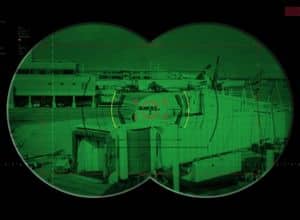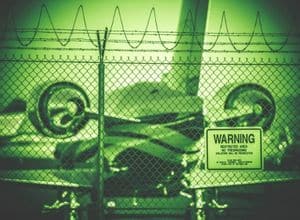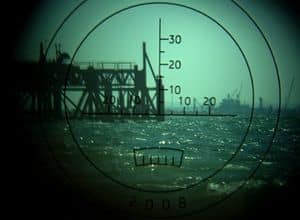Green and white phosphor night vision goggles have very different applications, as the green light is better in a dark environment, and white light is easier to see in a bright environment. So, how do you compare the green from white phosphor night vision?
Two different technologies are used in green and white phosphor night vision, which work with different wavelengths of light. Green and white light are typically used to assist in different situations. For instance, a night vision green scope helps the user to detect objects in dim light. On the other hand, white phosphor night vision assists the user in seeing a brighter light.
How Night Vision Works
Night vision goggles can see through a low-light scene in these simple steps:
- Dim light from a night scene passes through the lens at the front. As a result, the light comprises photons (particles of light) of every color.
- As the photons reach the goggles, they strike a light-sensitive surface called a photocathode.
- The electrons are amplified by a photomultiplier. To clarify, this is a kind of photoelectric cell. Thus, every electron entering the photomultiplier results in many more electrons leaving it.
- The electrons leaving the photomultiplier hit a phosphor screen, similar to the screen in an old-fashioned television. Then, as the electrons hit the phosphor, they create tiny flashes of light.
- Since there are many more photons than originally entered the goggles, the screen makes a much brighter version of the original scene.
Let’s look deeper at green night vision vs. white phosphor night vision and its uses.
What Is A Night Vision Phosphor Screen?

A night vision phosphor screen is just a fancy name for a phosphor. In other words, it’s a layer of phosphor on a piece of glass that is used to create an image. The screen has multiple layers, with different phosphors on each layer. The phosphor screens on night vision devices are often red, green, or blue, depending on the wavelengths of light the device uses.
For example, if you look at the front of a digital camera, you’ll notice that white LEDs illuminate the LCD panel. White LEDs emit light in the entire visible spectrum, so they are used to illuminate the LCD display and also to illuminate the night vision phosphor screens of cameras, binoculars, and night vision goggles.
Types Of Night Vision Devices
Night vision devices have three main types: green, white, and red.
Types of night vision devices come in various shapes and sizes, but all have one common goal: to allow you to see in the dark.
1. Green Night Vision Devices
Green night vision devices work best in bright light conditions. They use a medium power bulb to illuminate the area around your device. These devices are perfect for inspecting construction sites or tracking objects during an emergency.
2. White Night Vision Devices
White phosphor night vision works best in low-light conditions. They use a high-power bulb to illuminate the entire area around your device. This device is perfect for applications such as driving or short-range target shooting.
3. Red Night Vision Devices
Red night vision devices work best in very dark conditions. They use an ultra-high power bulb to illuminate the entire area around your device.
Green Vs. White Phosphor Night Vision: Similarities and Differences
The first thing of note about the similarities between white and green phosphors is that both are enhancers of night vision. They can be built-in devices that can be fixed to sniper rifles and similar arms. They are also built-in binoculars and goggles.

Another thing to mention about the two regarding similarities is that both function with dim light. Particularly, they don’t work at all where there is full darkness. Therefore, neither white nor green phosphor will work in areas such as dark tunnels, bunkers, basements, and blacked-out places. However, thermal night vision detectors are great alternatives in full darkness.
Irrespective of that, one must point out that both green and white phosphor night vision works just fine. As long as there’s some dim light, however low, in an area, the green night vision will work great. The same thing can be emphasized with white phosphor night vision.
Nevertheless, as anticipated, the white phosphor night vision is a later technology and, as such, has slight advantages over green night vision devices.
For instance, when getting better outcomes in warfare, white phosphor night vision wins a trophy. But the green night vision can suffice if it’s just about viewing images in low-light areas. This isn’t to say that green phosphor still isn’t being utilized by the military. However, it is being phased out due to the tactical edge of thermal devices and white phosphor night vision.
It’s also noteworthy that when using white phosphor night vision, you get more visual sharpness and contrast. This is because green phosphor aims at just one set of visual receptors (green) in the brain. On the contrary, white phosphor night vision supplies more information to all the image receptors in the brain. As a result, white phosphor produces much better brightness.
Another interesting result of that is that there is less strain on the eyes when using white phosphor night vision. If you will be using it for a long stretch of hours, white is a preferable option. This is because it has been proven to cooperate better with human eyes.
Advantages Of Using Green Phosphor
For more than four decades, green phosphor has been the industry standard. Green phosphor still stays the better choice for jungle or deep dark areas. These environments require enhanced contrast depth in order to operate. Green phosphor provides the higher gains and stronger contrasts needed for image clarity that is required to operate without the advantage of ambient light sources for image enhancement.
Green phosphors are very low energy, meaning that you don’t need to use a lot of battery power to get a good picture, making it perfect for those situations where you only have a limited amount of battery power (for example, if you’re using a camera on a drone).
They are also resistant to false positives, which means you don’t see what isn’t there. Green phosphors can be used both day and night, making them ideal for a range of applications. Meanwhile, the green night visions are also more sensitive than red phosphors, allowing you to see better in darker conditions.
Advantages Of Using White Phosphor
White phosphor night vision equipment has some advantages over traditional night vision goggles. It uses less power and can be used in lower-light environments.
Customers have noticed an increase in contrast with white phosphor. Professionals also say that these changes in color have been reported to enhance general object recognition even though providing contrast sensitivity equivalent to or far greater than traditional green phosphor tubes. Industry experts also conclude that “studies show that nighttime scenes seem noticeably much more all-natural in black and white.”

When using white phosphor night vision goggles, however, you must be in a position to distinguish the distinction between female and male figures at about 75 to 100 yards. Also, ask yourself if the resolution provided is adequate to recognize a shotgun at a distance. It is recommended not to buy on blooming alone but to consider distance and acquirement adjustments as well.
Also, the white phosphor night vision equipment is generally a good choice for military and police applications because it is less expensive than traditional night vision technology.
Is Green Or White Night Vision Better?
A lot depends on which brand, model, and type of optical system. Some systems are made for one specific purpose. For instance, some night vision systems were designed to be used by helicopter pilots. The quality of night vision is best during certain conditions like dusk and dawn.
Generally, the color spectrum available at night can range from deep blue to red or orange depending on the type of light pollution in the area where the aircraft is flying.

